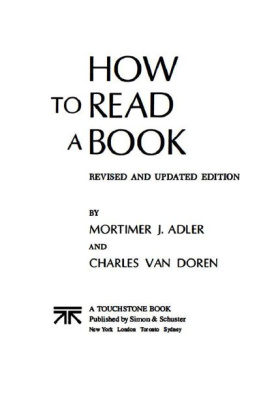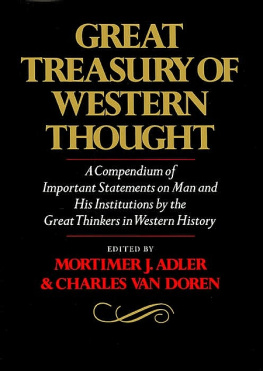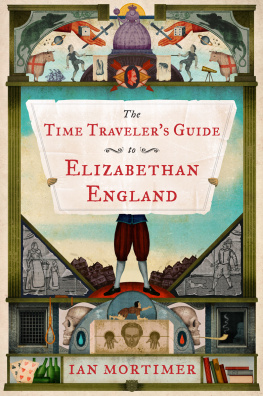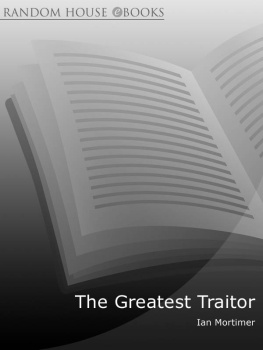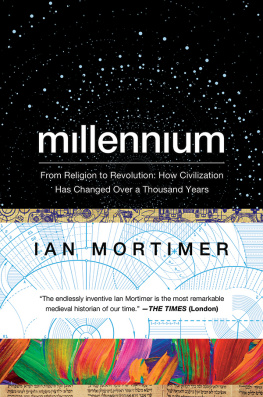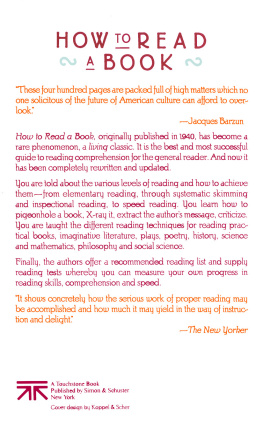Mortimer J. Adler - How to Read a Book: The Classic Guide to Intelligent Reading
Here you can read online Mortimer J. Adler - How to Read a Book: The Classic Guide to Intelligent Reading full text of the book (entire story) in english for free. Download pdf and epub, get meaning, cover and reviews about this ebook. year: 2011, publisher: Simon and Schuster, genre: Children. Description of the work, (preface) as well as reviews are available. Best literature library LitArk.com created for fans of good reading and offers a wide selection of genres:
Romance novel
Science fiction
Adventure
Detective
Science
History
Home and family
Prose
Art
Politics
Computer
Non-fiction
Religion
Business
Children
Humor
Choose a favorite category and find really read worthwhile books. Enjoy immersion in the world of imagination, feel the emotions of the characters or learn something new for yourself, make an fascinating discovery.
- Book:How to Read a Book: The Classic Guide to Intelligent Reading
- Author:
- Publisher:Simon and Schuster
- Genre:
- Year:2011
- Rating:4 / 5
- Favourites:Add to favourites
- Your mark:
- 80
- 1
- 2
- 3
- 4
- 5
How to Read a Book: The Classic Guide to Intelligent Reading: summary, description and annotation
We offer to read an annotation, description, summary or preface (depends on what the author of the book "How to Read a Book: The Classic Guide to Intelligent Reading" wrote himself). If you haven't found the necessary information about the book — write in the comments, we will try to find it.
Mortimer J. Adler: author's other books
Who wrote How to Read a Book: The Classic Guide to Intelligent Reading? Find out the surname, the name of the author of the book and a list of all author's works by series.
How to Read a Book: The Classic Guide to Intelligent Reading — read online for free the complete book (whole text) full work
Below is the text of the book, divided by pages. System saving the place of the last page read, allows you to conveniently read the book "How to Read a Book: The Classic Guide to Intelligent Reading" online for free, without having to search again every time where you left off. Put a bookmark, and you can go to the page where you finished reading at any time.
Font size:
Interval:
Bookmark:
Thank you for downloading this Simon & Schuster ebook.
Get a FREE ebook when you join our mailing list. Plus, get updates on new releases, deals, recommended reads, and more from Simon & Schuster. Click below to sign up and see terms and conditions.
CLICK HERE TO SIGN UP
Already a subscriber? Provide your email again so we can register this ebook and send you more of what you like to read. You will continue to receive exclusive offers in your inbox.

How to Read a Book was first published in the early months of 1940. To my surprise and, I confess, to my delight, it immediately became a best seller and remained at the top of the nationwide best-seller list for more than a year. Since 1940, it has continued to be widely circulated in numerous printings, both hardcover and paperback, and it has been translated into other languagesFrench, Swedish, German, Spanish, and Italian. Why, then, attempt to recast and rewrite the book for the present generation of readers?
The reasons for doing so lie in changes that have taken place both in our society in the last thirty years and in the subject itself. Today many more of the young men and women who complete high school enter and complete four years of college; a much larger proportion of the population has become literate in spite of or even because of the popularity of radio and television. There has been a shift of interest from the reading of fiction to the reading of nonfiction. The educators of the country have acknowledged that teaching the young to read, in the most elementary sense of that word, is our paramount educational problem. A recent Secretary of the Department of Health, Education, and Welfare, designating the seventies as the Decade of Reading, has dedicated federal funds in support of a wide variety of efforts to improve proficiency in this basic skill, and many of those efforts have scored some success at the level at which children are initiated into the art of reading. In addition, adults in large numbers have been captivated by the glittering promises made by speed-reading coursespromises to increase their comprehension of what they read as well as their speed in reading it.
However, certain things have not changed in the last thirty years. One constant is that, to achieve all the purposes of reading, the desideratum must be the ability to read different things at differentappropriatespeeds, not everything at the greatest possible speed. As Pascal observed three hundred years ago, When we read too fast or too slowly, we understand nothing. Since speed-reading has become a national fad, this new edition of How to Read a Book deals with the problem and proposes variable-speed-reading as the solution, the aim being to read better, always better, but sometimes slower, sometimes faster.
Another thing that has not changed, unfortunately, is the failure to carry instruction in reading beyond the elementary level. Most of our educational ingenuity, money, and effort is spent on reading instruction in the first six grades. Beyond that, little formal training is provided to carry students to higher and quite distinct levels of skill. That was true in 1939 when Professor James Mursell of Columbia Universitys Teachers College wrote an article for the Atlantic Monthly entitled The Failure of the Schools. What he said then, in two paragraphs that I am now going to quote, is still true.
Do pupils in school learn to read their mother tongue effectively? Yes and no. Up to the fifth and sixth grade, reading, on the whole, is effectively taught and well learned. To that level we find a steady and general improvement, but beyond it the curves flatten out to a dead level. This is not because a person arrives at his natural limit of efficiency when he reaches the sixth grade, for it has been shown again and again that with special tuition much older children, and also adults, can make enormous improvement. Nor does it mean that most sixth-graders read well enough for all practical purposes. A great many pupils do poorly in high school because of sheer ineptitude in getting meaning from the printed page. They can improve; they need to improve; but they dont.
The average high school graduate has done a great deal of reading, and if he goes on to college he will do a great deal more; but he is likely to be a poor and incompetent reader. (Note that this holds true of the average student, not the person who is a subject for special remedial treatment.) He can follow a simple piece of fiction and enjoy it. But put him up against a closely written exposition, a carefully and economically stated argument, or a passage requiring critical consideration, and he is at a loss. It has been shown, for instance, that the average high school student is amazingly inept at indicating the central thought of a passage, or the levels of emphasis and subordination in an argument or exposition. To all intents and purposes he remains a sixth-grade reader till well along in college.
If there was a need for How to Read a Book thirty years ago, as the reception of the first edition of the book would certainly seem to indicate, the need is much greater today. But responding to that greater need is not the only, nor, for that matter, the main motive in rewriting the book. New insights into the problems of learning how to read; a much more comprehensive and better-ordered analysis of the complex art of reading; the flexible application of the basic rules to different types of reading, in fact to every variety of reading matter; the discovery and formulation of new rules of reading; and the conception of a pyramid of books to read, broad at the bottom and tapering at the topall these things, not treated adequately or not treated at all in the book that I wrote thirty years ago, called for exposition and demanded the thorough rewriting that has now been done and is here being published.
The year after How to Read a Book was published, a parody of it appeared under the title How to Read Two Books; and Professor I. A. Richards wrote a serious treatise entitled How to Read a Page. I mention both these sequels in order to point out that the problems of reading suggested by both of these titles, the jocular as well as the serious one, are fully treated in this rewriting, especially the problem of how to read a number of related books in relation to one another and read them in such a way that the complementary and conflicting things they have to say about a common subject are clearly grasped.
Among the reasons for rewriting How to Read a Book, I have stressed the things to be said about the art of reading and the points to be made about the need for acquiring higher levels of skill in this art, which were not touched on or developed in the original version of the book. Anyone who wishes to discover how much has been added can do so quickly by comparing the present Table of Contents with that of the original version. Of the four parts, only Part Two, expounding the rules of Analytical Reading, closely parallels the content of the original, and even that has been largely recast. The introduction in Part One of the distinction of four levels of readingelementary, inspectional, analytical, and syntopicalis the basic and controlling change in the books organization and content. The exposition in Part Three of the different ways to approach different kinds of reading materialspractical and theoretical books, imaginative literature (lyric poetry, epics, novels, plays), history, science and mathematics, social science, and philosophy, as well as reference books, current journalism, and even advertisingis the most extensive addition that has been made. Finally, the discussion of Syntopical Reading in Part Four is wholly new.
Next pageFont size:
Interval:
Bookmark:
Similar books «How to Read a Book: The Classic Guide to Intelligent Reading»
Look at similar books to How to Read a Book: The Classic Guide to Intelligent Reading. We have selected literature similar in name and meaning in the hope of providing readers with more options to find new, interesting, not yet read works.
Discussion, reviews of the book How to Read a Book: The Classic Guide to Intelligent Reading and just readers' own opinions. Leave your comments, write what you think about the work, its meaning or the main characters. Specify what exactly you liked and what you didn't like, and why you think so.




